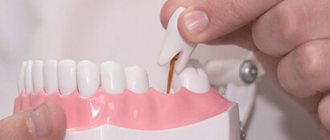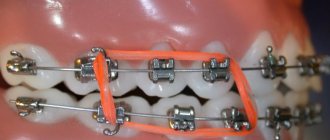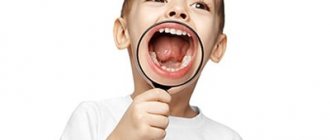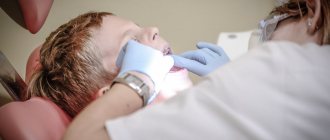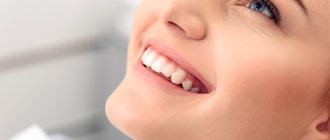Treatment of dental pathologies in children is a complex process that requires extensive practical experience and knowledge of child psychology. Especially when it comes to baby teeth. In order not to damage the rudiments of permanent units, the doctor must perfectly know the technique of performing manipulations and act very carefully.
Children's doctors at the Levoberezhnaya Dental Clinic try to save teeth even with extensive damage and remove them only as a last resort. You can make an appointment by calling the phone number listed on the website or using the online form.
Features of treatment of children's teeth
Dental treatment in childhood requires compliance with a number of features. The methods are similar to those used for adults, but there are some differences. In general, pediatric dentistry is a separate “world” in which only experienced doctors who know how to approach children work. This requires a lot of experience and communication skills with young patients, since in some cases you have to try hard to calm the child down and carry out treatment in a favorable environment for him.
How to treat teeth at 1 year old
The first visit to the dentist is recommended at the age of one year. During the initial appointment, the specialist carefully examines not only the milk teeth, but also the frenulum of the lips and tongue. A visit to the doctor at this age is extremely necessary to promptly detect and then eliminate:
- bite defects;
- frenulum abnormalities;
- gum pathologies and other possible disorders.
If any diseases are discovered during the examination, the specialist prescribes treatment. If there is an assumption that manipulations may cause pain or discomfort to the child, anesthesia is used.
How to treat teeth at 2–3 years old
At the age of two to three years, for preventive purposes, the child should be taken to an appointment not only with a dentist, but also with a hygienist, since during this period most children usually erupt all their milk teeth, and they require special care. At the initial appointment, the doctor examines the oral cavity and assesses the correctness of the bite. In addition, all baby teeth are checked for cavities.
Most often, at 2–3 years of age, caries is diagnosed at the “spot” stage, when deep tissue structures have not yet been affected. In this case, two treatment methods are usually used:
- Remineralization.
The procedure is painless and performed without anesthesia. The method is based on the use of special compounds based on fluorine, calcium and phosphorus. The product is applied directly to the affected area and allows you to restore the mineral balance of the tooth.
- Silvering.
During the procedure, the teeth are coated with a special silver-based compound, which protects the enamel for a long time and prevents the re-development of caries.
Most often, using such methods, the stain is removed without instrumental intervention. If caries has affected deeper layers, it is impossible to do without removing the affected tissue, cleaning and filling.
How to treat teeth at 4–5 years old
If during diagnosis the doctor discovers caries, the most common disease at this age, treatment is prescribed according to the following algorithm:
- treatment of the oral cavity with antiseptic drugs;
- applying “freezing” agents to the gums in the area where the anesthetic was administered;
- injection administration of anesthesia;
- removal of affected tissue using special tools or a drill;
- filling.
The whole process takes about 30–40 minutes, sometimes more depending on the size and severity of the caries, and the child does not feel anything, since the procedure is carried out only after the anesthesia has taken effect.
If gum disease is diagnosed, topical agents are most often prescribed - ointments, creams, gels, as well as rinsing the mouth with pharmaceutical solutions or tinctures of medicinal herbs. In severe forms of pathologies, medications can be prescribed that eliminate inflammation and relieve painful symptoms.
How to treat teeth for children over 5 years old
At the age of 5 to 7 years, the replacement of baby teeth with permanent ones begins. During this period, particularly careful hygiene and regular visits to the dentist are required, as it is necessary to monitor the condition of the enamel, which is formed gradually over 2–4 years.
After 7 years, bite problems often arise. This is due to the fact that instead of a gradual increase in the jaw in proportion to the growth of permanent teeth, some kind of failure occurs, as a result of which anomalies appear - incomplete closure, displacement of the dentition, malocclusion, etc. In such cases, the therapeutic course includes not only wearing braces and other orthopedic structures, but also visiting a speech therapist.
Why do baby teeth hurt?
The fact that dental treatment is necessary at any age is irrefutable. But why do kids get toothache so often? There are several explanations for this, and they all have to do with the structural features of children's teeth. This means:
- Very thin and insufficiently mineralized enamel. It cannot withstand the aggressive influence of sugar, traumatic damage, or mechanical stress. It is easily destroyed by the accumulation of soft plaque, in which pathogenic microorganisms actively multiply. It is because of this that in children, caries in the form of a spot can turn into a huge “hollow” in a few weeks. Then the deep layers of the child, pulp, and nerve endings become involved in the destructive process.
- Quite thin dentin. This promotes the rapid transition of bacteria from the external tissues of the tooth to the internal ones.
- Large pulp volume. It can be considered as suitable conditions for the spread of pathogens.
Most often, doctors diagnose caries in children. If you treat it immediately after the appearance of a white or dark spot, the prognosis will be favorable. Most likely, the unit will remain until it is pushed out by a more durable permanent replacement. If you let the carious process take its course, within six months or a year the destruction will become so extensive that it will have to be removed.
Treatment of baby teeth
To prevent the child from getting scared and feeling pain, anesthesia is carried out in two stages. To begin with, a “freezing” spray or gel is applied to the gums, and then an anesthetic drug is injected with a syringe with a very thin needle. After the anesthesia begins to take effect, the affected tissue is carefully removed using a special instrument, and then the cavity is filled with materials containing fluoride and other mineral components that strengthen the teeth. The treatment is carried out in sessions, each of which lasts no more than 30 minutes, so that the child does not get tired and start being capricious.
Sealing teeth in children
On the chewing surface of the teeth there are natural depressions - fissures. This is where food debris accumulates the most, since children cannot clean it properly. And this is where caries most often develops.
We will carry out a painless and effective procedure that will protect your teeth from carious bacteria. The doctor will cover the fissures with a thin layer of filling material. For this we use high quality liquid composites. The procedure is absolutely painless.
This layer will act as a protective coating and prevent bacteria from penetrating into the dental tissues.
Treatment of permanent teeth
Treatment of caries of permanent teeth in children is carried out according to the same principle as in adults, only with the use of special photocomposites.
Stages of treatment:
- Introduction of anesthesia.
- Removal of affected tissue. Typically, pathogenic foci are eliminated using a drill, after which the cavity is thoroughly cleaned.
- Treatment of teeth with antiseptic preparations.
- Drying with air jet.
- Application of phosphate cement insulating material.
- Filling.
The initial stage of caries is treated with remineralization or, for example, ozone therapy. The silvering method is not used for permanent teeth.
Do baby teeth need to be treated?
Many people believe that if a tooth falls out anyway, then it does not need treatment. In fact, this is far from the case. Baby teeth perform very important functions. They ensure proper growth of the jaw, protect the rudiment of the permanent unit from infection by pathogenic microbes and prevent the development of malocclusion. If a baby tooth is not treated, caries penetrates deep into the tissue, which inevitably causes damage to the rudiment. In the future, this leads to various pathologies, including dental anomalies, speech disorders and much more. To avoid this, it is very important to carry out timely treatment of baby teeth at the first stage of disease development, and not to remove them.
Dental treatment under anesthesia
In most cases, treatment is carried out after the introduction of anesthesia, which is divided into two types - application with local application of medication and injection, which involves the administration of an injection. The second option is safer and more effective.
If a child has panic fear or is simply restless, anesthesia is used, but before using it, a number of diagnostic measures are prescribed:
- biochemical blood test;
- general blood and urine tests;
- blood to determine sugar levels;
- electrocardiography to assess the state of the heart.
You should not eat food 5–6 hours before anesthesia, and drink water and other liquids 4 hours before.
Sleep is induced very gradually using sevoflurane-based gas. If the child needs to be woken up, the doctor increases the amount of oxygen supplied, and this can be done at any time. After waking up, all reflex functions are fully restored within the first 15 minutes. As a rule, there are no complications.
What to do if a child does not allow or is afraid to have his teeth treated?
Many children experience panic, so it is very important to intelligently approach the question of how to properly persuade a small child to have their teeth treated. To make the process painless and, perhaps, even positive, adhere to the following rules:
- Meet the doctor.
This should be done not at the moment when the tooth is already sick, but in advance - during a preventive examination.
- Motivation.
The child does not know why this is needed and what awaits him in general, so you should tell him about the importance of the procedure or, for example, show him in a playful way on his favorite toy.
- Elimination of physical force.
If a child resists, is capricious and protests, he should not be forced into the dental chair. This will not only traumatize the psyche, but will also completely discourage you from visiting dentists. Here it is better to act carefully - persuade, talk about the great benefits of treatment, or offer a new toy as a present.
- Timing.
If treatment is required, you should see a doctor without delay, but you should also consider the child’s needs. If he is used to, for example, sleeping at a certain time, you should not go to the doctor at that very moment. This is fraught with bad mood and whims. First, let your child sleep, and only after that get ready for the dentist. The same goes for eating, playing and other hobbies.
- Do not lie.
Many parents say that the doctor will only look and do nothing. This is a very big mistake, because the child expects one thing, but in the end it turns out something completely different. It will be better if you tell him the truth in a positive way.
Another good way to motivate your child is by example. If you regularly visit a doctor for preventive purposes and talk about the benefits of procedures, then your child will follow your example.
Is it possible to completely prevent the development of caries in childhood?
Perhaps, if parents conscientiously follow all the doctor’s recommendations regarding nutrition and the prevention of carious lesions, they systematically come for preventive examinations, which are prescribed by the attending physician.
It is necessary to take care of baby teeth and carry out treatment in a timely manner. You need to take care of your child’s teeth from the appearance of the first tooth. Parents should approach oral care responsibly, teaching their child to take care of hygiene. It is not difficult to interest a child now - parents will be helped by unusually designed toothbrushes, pleasant-tasting toothpastes, and, if desired, even such a routine activity as brushing teeth can be turned into an interesting game.
Pediatric dentistry will help you - during your appointment at our clinic, hygiene lessons are held - specialists tell and show how to properly brush your teeth. Let your children be healthy, happy and smiling!
Where to treat children's teeth
To ensure that the procedure is quick and successful, contact only licensed medical institutions with competent specialists. Doctors at the Levoberezhnaya Dental Clinic have been specializing in dental treatment for children for many years. Our dentists are very sensitive to young patients and know how to eliminate pathologies as quickly and painlessly as possible.
If you have any questions, please call us at. We are located at: Moscow, Belomorskaya st., 1, and work for you every day from 9.00 to 21.00.


